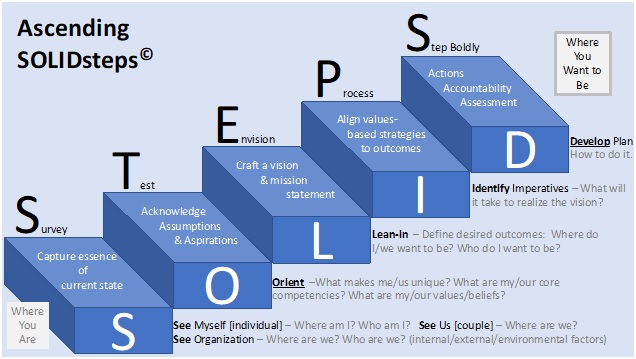A Coaching Model Created by Michael Rauhut
(Executive Coach, Life Transition Coach, UNITED STATES)
Introduction
Many people experiencing personal or professional transitions are uncertain how to move forward; how to get from where they are to where they want to be. Intimidated or overwhelmed, most rely on whatever got them to their current state. When this works to move them forward, no issue. When they get stuck, there is no moving onward or upward.
Irrespective of the type of transition—professional, personal, or both—change is hard. Navigating transitions without a framework exasperates individuals and organizations, proves inefficient and ineffective, and often contributes to feelings of personal discouragement or organizational malaise for both leaders and leaders. Achieving personal growth and/or organizational success requires a clear-eyed, iterative, and genuine approach. Ascending SOLIDsteps© is one such approach.
The Model
The SOLIDsteps© model reflects a unique blend of my own model, and others’ transition models, and incorporates ideas adapted from Dr. Kotter’s “8-Step Process for Leading Change”, Simon Sinek’s “How Great Leaders Inspire Action”, and my own experience as a U.S. Army leader and fellow with the Halftime Institute.[1]
The illustration in Figure 1 (next page) reflects the general approach I take with clients (individual or corporate) desiring to move from where they are to where they want to be. It is applicable at the individual, group (couples, small groups), or organizational levels with allowance made for what makes each unique. The title is inspired by my parent’s story and borrows my father’s expression for his own life journey.[2]
 Figure 1. The SOLIDsteps© Model
Figure 1. The SOLIDsteps© Model
The acronym SOLID reflects the sequence or progression, I work through with clients seeking change. With each descriptive element (S-O-L-I-D) is a corresponding action (S-T-E-P-S) and desired outcome as reflected on each step. The process starts with the client seeing themselves (where they are; what’s going on around them; what are the internal and external factors impacting them; understanding who they are; understanding their environment) through coaching exploration and survey and to capture the essence of the client’s current state. This step is essential for the client’s deeper understanding of where they are and begins to open their minds for deeper, subsequent exploration. Next, we orient on the client’s inherent uniqueness—exploring values, beliefs, strengths, core competencies, etc.—to test their own self-awareness, acknowledge underlying assumptions, and clarify their aspirations. With this enhanced self-awareness, the client and coach then lean into where the client wants to be, who they want to be, and what they want. This step elicits clients envisioning their future state. Clearly defining desired outcomes around who they aspire to be, where they want to be, and/or what they want enables crafting vision and mission statements to focus subsequent action. Identifying what it will take to achieve those aspirations comes through identifying imperatives. This is where the process kicks in to align the self-aware client and their desired outcomes, using values-based strategies they develop. These values-based strategies are more likely to succeed when authentically crafted by the client. The imperatives also prove helpful for the client in delineating importance and helping with decision-making. Finally, we focus on developing an action plan which holds the client accountable and provides feedback for assessing how they are doing. Armed with their plan—designed to achieve the client’s desired outcomes, aligned with their values, and shaped by their self-awareness—the client can step boldly and confidently forward.
It is important to note that this is a descriptive, rather than prescriptive, model. As part of my coaching practice, I aspire to share the “why” of my coaching and allow the “how” and “what” to flow organically. There may be times when the client needs to revisit a topic or remind themselves of their learning, all of which can be enhanced by quality coaching. The client need not be burdened by the illustration in Figure 1, nor feel that it must be liturgically followed. For those for whom the understanding structure is important, I may share both the visual and describe the process when it would help the client feel more comfortable.
How long or how many sessions this model requires largely depends on the client’s needs. If the client is an individual, couple, or small group, the model may accommodate as few or as many sessions each feels is needed to move forward with their unique plan. If facilitating an organizational process, this model is adaptable to discrete, non-concurrent sessions or a series of concurrent sessions, again based on organizational needs. Short workshops with time in between (hours/days/weeks) for small group collaboration can yield interesting and very beneficial results while also creating buy-in and ownership.
Conclusion
The SOLIDsteps© model provides a way for coaches to connect with clients experiencing important life transitions. As with any model, it requires authentic and genuine coaches to care most about client needs rather than an artificial, prescriptive application of steps. Being present and seeing individuals, groups, or organizations experience their “aha” moment(s) remains one of the most gratifying experiences I have had in coaching. SOLIDsteps©can get you there.
[1]The transition models I experienced and most influenced me to include: 1) U.S. Army Pre-command Course material (2011); developed by Kansas State University, College of Business Administration, which itself focused on Dr. Kotter’s change model (See also https://www.kotterinc.com/8-steps-process-for-leading-change/ (accessed 20 May 2021)); 2) Simon Sinek “How great leaders inspire action” TED talk (https://www.ted.com/talks/simon_sinek_how_great_leaders_inspire_action?language=en (accessed 20 May 2021)); 3)and personal coaching models I experienced through the U.S. Army Pre-command Course2011 (True Growth https://truegrowthleadership.com) and the Halftime Institute2019-2020 (https://halftimeinstitute.org/programs/fellows-program/) (all accessed 20 May 2021). I adapted what I learned at the U.S. Army Pre-command Course and applied it to effect positive change in the organizations I subsequently was privileged to lead 2011-2019, ranging in size from 12 to 2,000+. The models work when genuinely applied. I further adapted these ideas for use in individual coaching based on my training and education through the International Coaching Academy.
[2]See Solid Steps Through Shifting Sand: Short Stories on a Long and Guided Trail of Tests and Wonders by Horst Wilfried Rauhut (Author), Michael Winfred Rauhut (Author). (accessed 20 May 2021)
